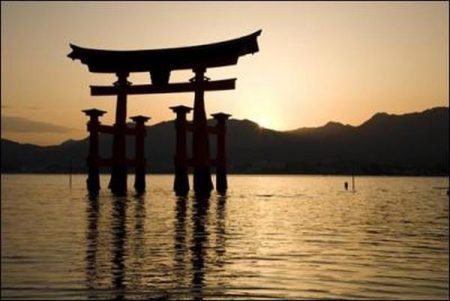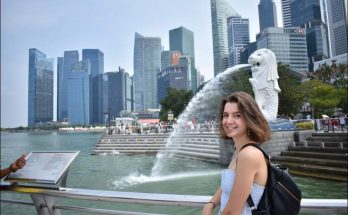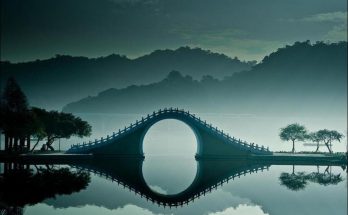Insular like Great Britain, Japan owes her fortunes largely to her ports and rivers, through which her needs and requirements were supplied from all parts of the world. Japan possesses around her coast many beautiful sights of sea and islet, and the Inland Sea is the quintessence of beauty and loveliness. Indeed, there may be more beautiful seascapes in other parts of the world, yet if so, the writer has not seen one, nor heard of anyone who has.
The site selected for the Inland Sea Park is really the most beautiful part of the Inland Sea. Roughly speaking the Park covers the sea coasts of three prefectures of Okayama, Hiroshima and Kagawa, extending from Shodoshima in the east to Itsukushima Shrine at Miyajima Romantic glimpse of the Inland Sea Cape Abuto in the west, and within its boundary it includes such famous scenic points as Kankakei Valley, Gokenzan Peaks, Yashima, the Shiaku Islands and Mt. Washu.
The Inland Sea comprises a winding stretch of sea water, 230 miles long, from Awaji to Shimonoseki. Its picturesque and prosperous coast-line, fringed with numerous indentations, white sand and green pines, is fashioned by the course of the sea. Seawards it looks upon the major islands of Awaji, Shikoku, Shodoshima and Kyushu, which shield it in from the outer oceans of the Pacific and the Japan Sea. On its bosom float numerous islets, some large enough to shelter thousands of people and others hardly larger than rocks. In all there are some 940 in number.
The sea is shallow, from 10 to 40 fathoms at the deepest part. There is hardly a ripple on its smooth, deep-green surface, as you glide over it on a big liner. The ship sails, as the oft-quoted Japanese phrase has it, “as on the matted floor,” and save for the throbbing of the engine, faintly heard from the depths of the ship, one scarcely feels he is on the surface of the sea. Every moment the surrounding scenery changes. It makes a marvelous cinematograph picture–the aspects of land, sea and island, and the sailing craft dotted here and there are constantly changing, creating a wonderful mosaic of light and shade. Every moment is a dream of enchanting panorama.
The Inland Sea has numerous beauty spots and places rich in historical and legendary lore. Many highland spots on the mainland and island offer points of vantage from which to view the sea. These places are increasing as improvement is being made in facilities for travel and accommodation, now that the site has come under the direct protection of the Government.
One may sample a fairly good view of the Inland Sea, or part of it at least, from the railway train running down the main San-yō line from Kobe to Shimonoseki. No less than four times the train comes in sight of the sea, the longest glimpse reserved for the last stage.
For historical and mythological associations, the story of the Inland Sea is largely the story of the Japanese Empire. From the early age of Jinmu Tenno, who took this water route on his famous eastward expeditions to Yamato in 7th century B.C., and through the Heian period, which marks the highest point in Japan’s literary and poetic culture, down to the era of Gen-pei, the scenes of Japan’s political, artistic and military activities were laid on the Inland Sea coast. It is rightly called the Mediterranean of Japan.
Modern Japan has changed much to suit the changing fashions of the world, but the manners and customs of old Japan, as shown in the classics, arts and literature are preserved, if at all, among the inhabitants of these islands. Most of them are, in these days of peaceful avocation, either farmers or fishermen, or both, but theirs was the stock from which has been drawn the hardy stuff to make the strength and prestige of new Japan. Many of Japan’s bravest seamen and most daring adventurers in industry and commerce have come from these islets.
We have no space to describe all the important sights usually pointed out to one visiting the Inland Sea, and the following are a mere catalogue of some of the major attractions.
Shōdoshima, (90 miles in circumference with 188,500 population), is of granite formation, and rich in beauty and historical associations. One of its beauty spots is Kankakei, a lovely mosaic of rock, tree (maples) and running water. It is part of Mount Kankakei, from whose top, 1,000 feet high, one obtains a splendid view of the sea.
The Island of Shikoku (1,648 miles in circumference) may stand quite on its own, but that scenic part, facing the Inland Sea, is included in the Park, especially Yashima where the famous bloody battle was fought between the Taira and Minamoto clans in the 12th century. Takamatsu, the most important city of Shikoku, which is a good starting point of tours round the island, is not included in the Park area.
Tomo, 7.6 miles south of the city of Fukuyama on the San-yo main line on the main island, is another famous resort, rich in fine scenery. The waters round about teem in fish, especially tai (the sea bream), the king of Japanese fish.
Washūzan is another vantage point from which to enjoy the sights of the sea. This part was once noted for the daring pirates who infested the Inland Sea in the middle ages.
Besides fishing, the mainland coast of the Inland Sea boasts of several industries, the chief among them being shipbuilding (there are 7 important dockyards), and the salt industry which yearly produces 90 per cent. of Japan’s salt.
Wonder has been expressed that the famous Miyajima, only 60 miles from Tomo of the Inland Sea, has not been included in the Inland Sea area. The reason for this omission is probably because the main island along which the Inland Sea flows, fashioning its shape, abounds in so many famous sights that they cannot all be included under one category. The best time to enjoy the manifold beauties of the Inland Sea Park is early summer and autumn.
Visits: 84



